Cite this document
(“How the Hop Hop Music Culture Spread Into Eastern Countries Essay”, n.d.)
Retrieved from https://studentshare.org/music/1412957-how-the-hop-hop-music-culture-spread-into-eastern-countries
Retrieved from https://studentshare.org/music/1412957-how-the-hop-hop-music-culture-spread-into-eastern-countries
(How the Hop Hop Music Culture Spread Into Eastern Countries Essay)
https://studentshare.org/music/1412957-how-the-hop-hop-music-culture-spread-into-eastern-countries.
https://studentshare.org/music/1412957-how-the-hop-hop-music-culture-spread-into-eastern-countries.
“How the Hop Hop Music Culture Spread Into Eastern Countries Essay”, n.d. https://studentshare.org/music/1412957-how-the-hop-hop-music-culture-spread-into-eastern-countries.


